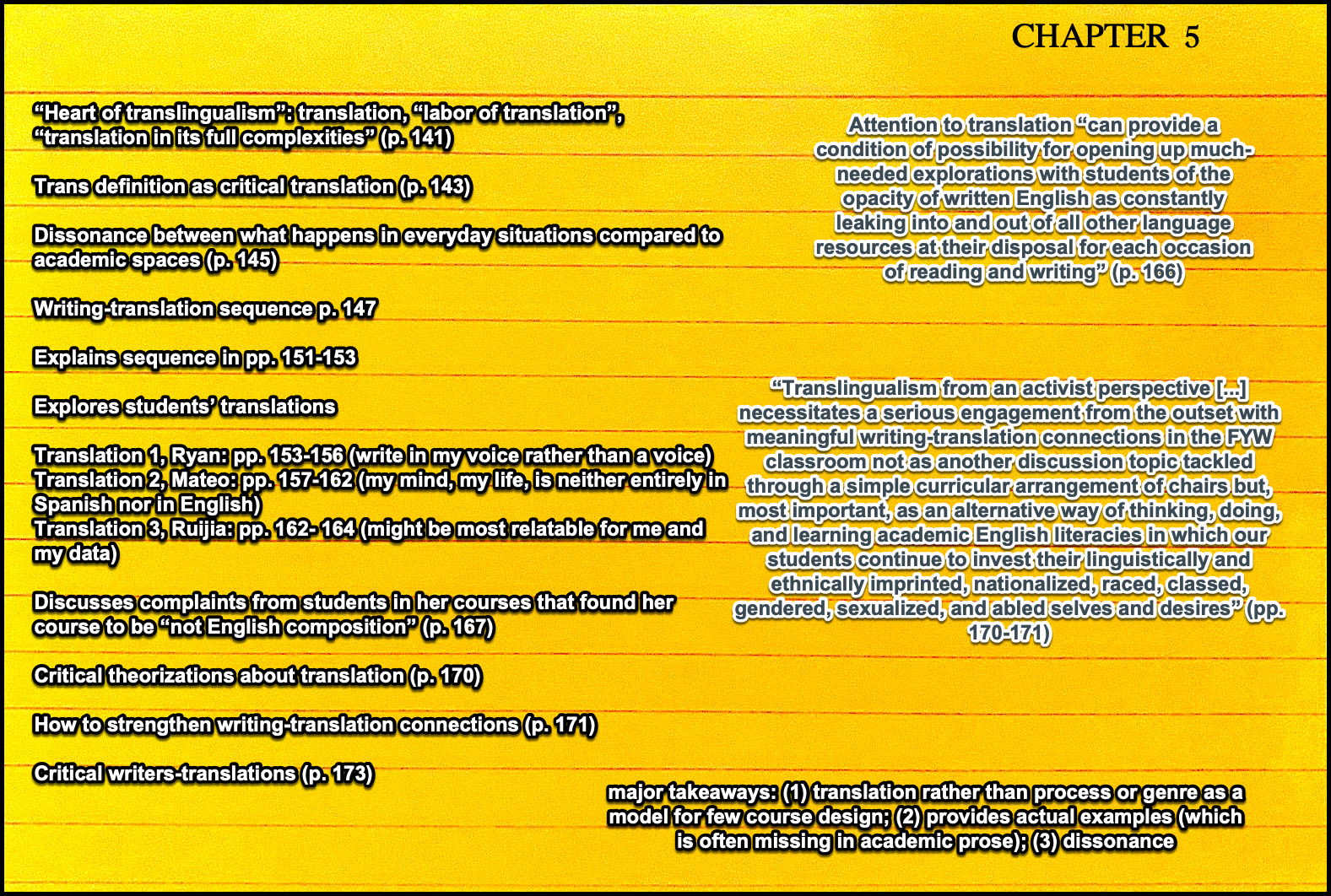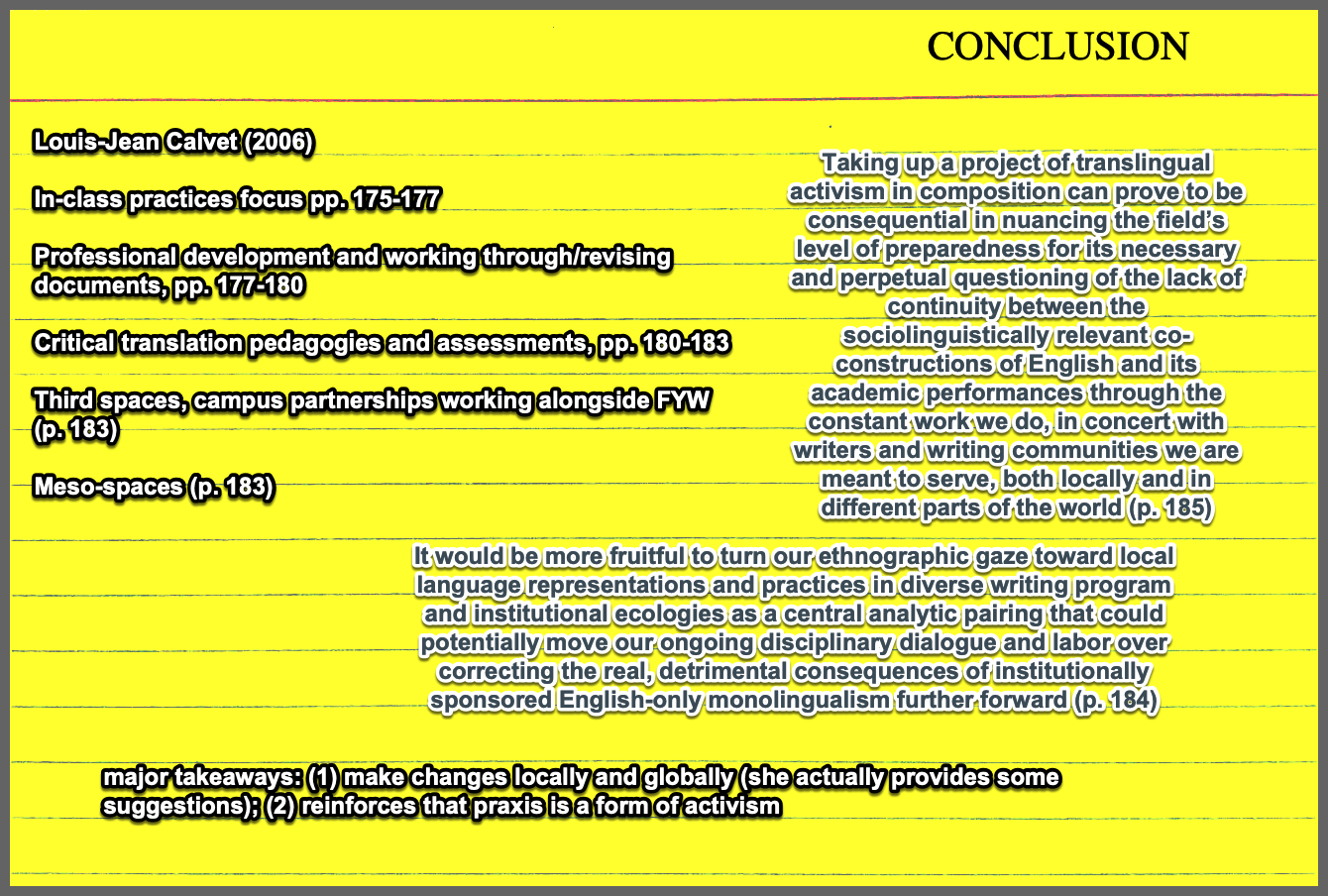Review of Toward Translingual Realities in Composition: (Re)Working Local Language Representations and Practices, by Nancy Bou Ayash
Review by Yasmine Romero
Translating the Complex and Nuanced Ideas of Translingualism into Actual Practice and Policy

Wrapping Up
While wrapping up the recording for my podcast, I start to browse through my notecards on the final two chapters of Nancy Bou Ayash's (2019) book as well as my highlights of sections of the texts, my post-it notes, and any marginal comments. As I thumb through, I see emails pop up in my inbox alerting me to student questions and concerns. One stands out: "What do you mean by student incomes?" I consider the term and realize that it may not be used explicitly by any of the texts we cover in our K–12 Expository English course. I prepare an announcement for the course where I define the term as
a student's background, that is, their history, their socioeconomic status, their languages, their identities, their work experiences, their interests; it also means that with these income aspects speak to techniques, processes, templates, and strategies that students rely on to complete writing assignments.
I provide an example as well:
For example, the 5-paragraph template you are taught in High School is what you rely on to accomplish an essay at the college-level. This template is one student income, even if many of us dislike it (and our mentors as well). However, this template can help us, according to some teacher-scholars, understand college writing if we are given the tools, opportunities and discussions to translate, revise, and adapt it to each rhetorical situation.
I hit send, and return to broadly summarizing Bou Ayash's last two chapters. My typing is slow, as I keep the author's words at my level using the clips of a book stand. I also have multiple tabs open with my notes, pictures of my marginal comments, and memos that I jotted down while reading her book.
In the final two chapters, Bou Ayash not only provides clear examples of how to integrate translation into first-year writing assignments but also makes a broader argument for writing classrooms and their institutions. Her assignments were piloted in two different sections of first-year writing: mainstream and multilingual (or L2). While the first half of her class was dedicated to becoming familiar with multiple kinds of literacies and semiotic resources, the second half revisits the writing assignments from the first in the form of critical translations.
I stare at my summary, knowing that what I have learned from these two chapters is nowhere present in this short blurb. There is nothing about translingual activism. I have no critique present or ready. I also have no examples to work through, but the student incomes announcement eats at my brain.
I search the chapters for a way to guide my thought process and the present review. I find her reconnection to her student Ruijia interesting, especially since Bou Ayash has been transparent about her scaffolding of assignment sequences and how students respond to them. Ruijia asks readers to do the work, rather than the writer. This demand is similar to what Bou Ayash asks at the beginning of Towards Translingual Realities in Composition.
I know that most conventional academic American readers expect me to explain my main argument at the beginning of my essay. However, as a writer who was educated in an eastern culture and whose writing is inspired by the work of an established Chinese writer Xun Lu, I choose to write this essay following a Chinese writing style that keeps the main argument at the end of a writing piece. Due to the complexity and richness of my experiences [with language], readers of my essay need to be a patient because my deep feelings [about language] that have changed over time cannot be captured by a single statement or two. I hope this decision would encourage my readers to focus more on my personal experiences and collaborate with me in order to grasp my conclusion about the power of language in expressing ones feelings and emotions and bringing different writing styles and cultures together. (Ruijia, freshman English student Fall 2013, as quoted in Bou Ayash, 2019, p. 3)
I push back from my desk, staring up through the jalousie windows. Two mynah birds perch themselves on the glass. I pause. I think. I ask myself, "But can I make this matter?" I search the final chapter for an answer, and I compile a list from Bou Ayash's (pp. 174–185) suggestions:
- Translingual-oriented in-class practices and assignment scaffold sequences. She shares her own set of an assignment sequence on pages 151–153.
- Reworking and revising policy documents, such as documents on language use and program's stances towards languaging, through professional development opportunities
- Creating awareness of translingualism through working with campus partners and/or establishing spaces for students to experiment, mesh, and innovate
- Revisiting assessment so that it is more in line with translingualism goals and values
- Continuing to conduct research that supports translingual activism
Lessons Learned
I find myself gravitating towards item four, that is, revisiting assessment. I read through assessment data that I have collected since starting my position at my home institution. I comb through the student writing samples, our process sheets, and the memorandums my colleagues and I have created. I reflect on how we implemented these changes. More importantly, I consider Bou Ayash's assertion:
Translingualism from an activist perspective [...] necessitates a serious engagement from the outset with meaningful writing–translation connections in the FYW classroom not as another discussion topic tackled through a simple curricular arrangement of chairs but, most important, as an alternative way of thinking, doing, and learning academic English literacies in which our students continue to invest their linguistically and ethnically imprinted, nationalized, raced, classed, gendered, sexualized, and abled selves and desires. (pp. 170–171)
These intersectional factors or axes—or students' "selves and desires" (p. 171)—are one of the many reasons why my current institution invested in authentic assessment or assessment that creates authentic writing situations where students have support throughout the writing process from mentorship to brainstorming to editing and revision. This approach has been translated in multiple ways, but taking a translingual stance aligns with authentic assessment's commitment to transparency and holistic evaluations of students' writing abilities.
I decide to make connections to my assessment project by providing some historical context and then forge connections as to why this situation makes for a strong research site to take a translingual stance. I begin typing:
When COMPASS (Computer-adaptive Placement Assessment and Support System) became defunct, we had to have a way for students to enroll in first-year writing (FYW) courses. We have a full one-year FYW program at my home institution, which supports our demographic of nontraditional, Indigenous, and first generation students. In addition, we have a tutorial section that supports students who need more one-on-one support; this course is not remedial, although many students and non-English colleagues perceive it in that way. This perception was something we wanted to combat through clarification that the tutorial section was not for students "who do not write well" (i.e., have errors in their writing). It is for students who need extra support in becoming familiar with college structures, requiring more time for assignments, and needing one-on-one consultations. I should add that most students in the tutorial sections have extenuating circumstances that impact their lives like first generation students or veterans with post-traumatic stress disorder.
As such, we—my colleagues and I—researched multiple methods and are now on our way towards implementing directed self-placement. However, we started with in-person, timed testing sessions, which we called authentic assessment. These sessions gave us an opportunity to meet one-on-one with incoming students, share the process, and explain each of the courses and the rationale behind these courses. Students' buy-in was incredibly high. But when the pandemic hit, we had to change gears: We had to think of ways to make testing accessible to students off campus. We came up with an e-portfolio approach that mirrors our authentic assessment process. Students watched a vidcast, completed a Google Form, and submitted two examples of their work as well as a critically reflective letter. In their letter, they are asked to rate their examples and argue for what course they should be placed within.
We decided to shift towards directed self-placement because we saw the value in the e-portfolio approach, but also because wanted to focus more on students critically reflecting on where they should be, what their writerly goals are, and more. While the language ideologies do emerge in some of the responses, practical and fiscal concerns take precedence for many students. For example, veteran students have to pay out of pocket for our tutorial version of the course because the G.I. Bill does not cover it. As such, coming up with other ways to support students from these demographics is necessary. We are now in talks of building writing studios for students who cannot pay for these courses and need the extra tutorial support.
Taking the stance that Bou Ayash has in her work, reflecting on the assessment data, and following up with students and staff, we have been able to create a testing platform that attempts to capture the complexity of first-year writing, with attention to language ideologies as well as issues of socioeconomic status, race, gender, and other backgrounds coming together. Bou Ayash considers these issues; however, it feels language ideology remains the biggest factor in translingualism, when it might be more than just language difference; systemic racism and other forms of oppression also play a central role in what matters (Gilyard, 2016; Rhodes, 1996; Ruiz, 2021).
Takeaways
I wonder about other readers. I wonder how they—from graduate school students to scholars to administrators—might use this text more clearly. What kinds of work is made possible with a translingual stance? I add a page break, and then consider and reconsider the theoretical, practical and methodological takeaways of Toward Translingual Realities in Composition.
I think out of all of the options above, Bou Ayash clearly has some actionable ways to create change. While I have focused on assessment in this review, I also find myself gravitating towards policy change because I have found, alongside other antiracist pedagogies, that policy change is central to making other voices matter like Malika's and Nathalie's. Bou Ayash's work could inform the establishment of policies and procedures that open up languaging to be inclusive, rather than exclusive; to mesh not switch; to see each speaker–writer as having multiple resources that they can draw on rather than being limited to what is so-called "appropriate" or "correct" for said writing situation.
Scholars and leaders in our associations and fields can and should consider how Bou Ayash complicates translingualism; however, they need to consider accessible ways to do so. Translingualism can appear as a catch-all for languaging differences, yet it can also provide a strong working foundation for research and policy that strives to be better to the speaker–writers we interview, the speaker–writers we represent, the speaker–writers we should speak with, not for.
Undergraduate students, graduate students, and teachers alike can make local, in-class changes happen, such as course design, which includes sequences and assignments focused around translation. However, what is missing from Bou Ayash's text is the exigency for mentorship and safer spaces to discuss the resistance they may face or grapple with themselves.
Thus, I think Bou Ayash's suggestions are necessary, yet we as teachers, undergraduate students, and graduate students need to also know how to deal with the backlash, challenges, and accreditation expectations, and enrollment pressures. We need to know how to negotiate with administrators, parents (for K–12), and other campus partners. This "needing" could be addressed in professional development venues and/or through policy changes that lead to foundations to cite and create arguments for why we should do it this way and not that way.
Another thing that I feel is missing from Bou Ayash's suggestions is how to address supporting teachers in making curriculum and/or programmatic change. For some teacher-scholars, professional development opportunities, campus partnerships, and course design support are readily available, whereas for others, these resources are limited because of funding or politics. As such, teacher-scholars face disparities in how much agency they have in creating change in a curriculum or program. My question for Bou Ayash, then, is how can we address these issues at the institutional or association level?
Overall, I find myself coming back to Bou Ayash's book as I teach and research. I find myself enthralled by her languaging metaphors, the way she engages the student data she collected, and her passion and commitment to a kind of activism that any of us who are invested in languaging and writing can learn from.
I type these last thoughts, watching the cursor blink as I contemplate adding more or letting it sit, unsettled.

Notes

Chapter 5 Notes
- Quotations
- Attention to translation "can provide a condition of possibility for opening up much-needed explorations with students of the opacity of written English as constantly leaking into and out of all other language resources at their disposal for each occasion of reading and writing" (p. 166).
- "Translingualism from an activist perspective [...] necessitates a serious engagement from the outset with meaningful writing-translation connections in the FYW classroom not as another discussion topic tackled through a simple curricular arrangement of chairs but, most important, as an alternative way of thinking, doing, and learning academic English literacies in which our students continue to invest their linguistically and ethnically imprinted, nationalized, raced, classed, gendered, sexualized, and abled selves and desires." (pp. 170–171)
- Key Points
- "Heart of translingualism": translation, "labor of translation," "translation in its full complexities" (p. 141)
- Trans definition as critical translation (p. 143)
- Dissonance between what happens in everyday situations compared to academic spaces (p. 145)
- Writing-translation sequence p. 147
- Explains sequence in pp. 151–153
- Explores students' translations
- Translation 1, Ryan: pp. 153–156 (write in my voice rather than a voice)
- Translation 2, Mateo: pp. 157–162 (my mind, my life, is neither entirely in Spanish nor in English)
- Translation 3, Ruijia: pp. 162–164 (might be most relatable for me and my data)
- Discusses complaints from students in her courses that found her course to be "not English composition" (p. 167)
- Critical theorizations about translation (p. 170)
- How to strengthen writing-translation connections (p. 171)
- Critical writers-translations (p. 173)
- Major Takeaways: (1) translation rather than process or genre as a model for FYW course design; (2) provides actual examples (Which is often missing in academic prose); (3) dissonance

Chapter 6 Notes
- Quotations
- "It would be more fruitful to turn our ethnographic gaze toward local language representations and practices in diverse writing program and institutional ecologies as a central analytic pairing that could potentially move our ongoing disciplinary dialogue and labor over correcting the real, detrimental consequences of institutionally sponsored English-only monolingualism further forward" (p. 184)
- "Taking up a project of translingual activism in composition can prove to be consequential in nuancing the field's level of preparedness for its necessary and perpetual questioning of the lack of continuity between the sociolinguistically relevant co-constructions of English and its academic performances through the constant work we do, in concert with writers and writing communities we are meant to serve, both locally and in different parts of the world." (p. 185)
- Key Points
- Louis-Jean Calvet (2006)
- In-class practices focus, pp. 175–177
- Professional development and working through/revising documents, pp. 177–180
- Critical translation pedagogies and assessments, pp. 180–183
- Third spaces, campus partnerships working alongside FYW (p. 183)
- Meso-spaces (p. 183)
- Key Takeaways: (1) make changes locally and globally (she actually provides some suggestions); (2) reinforces that praxis is a form of activism